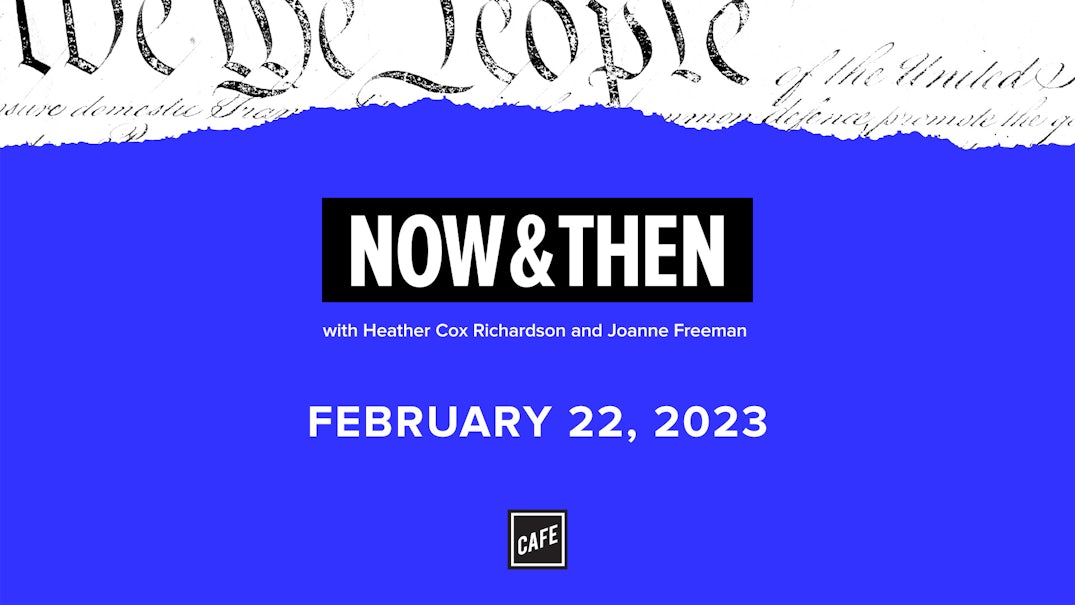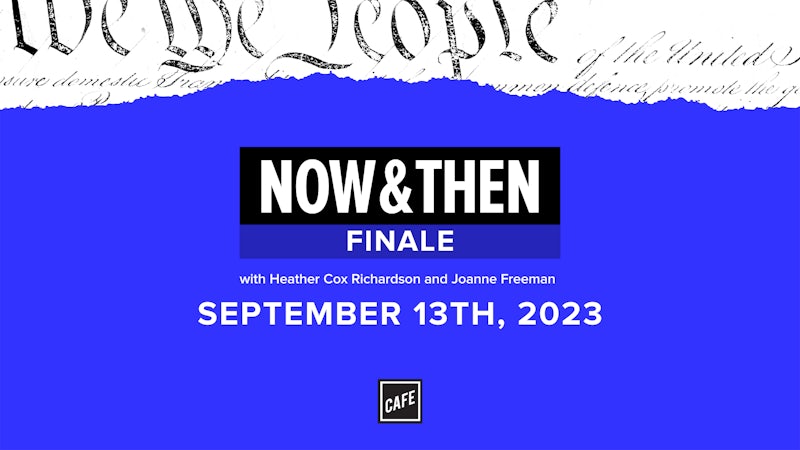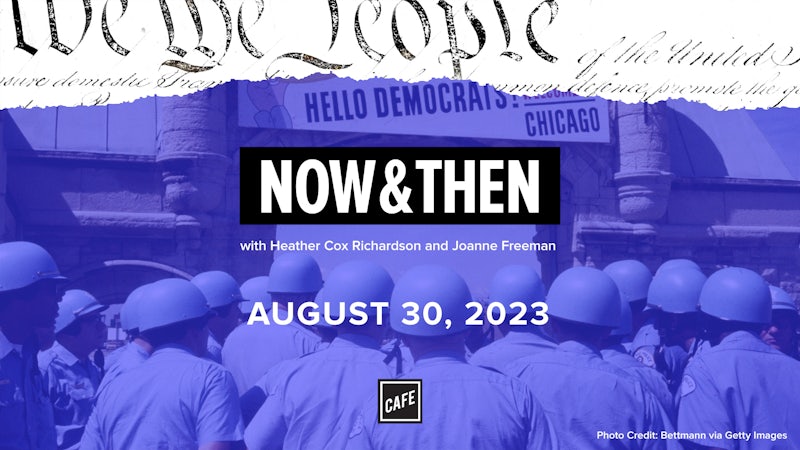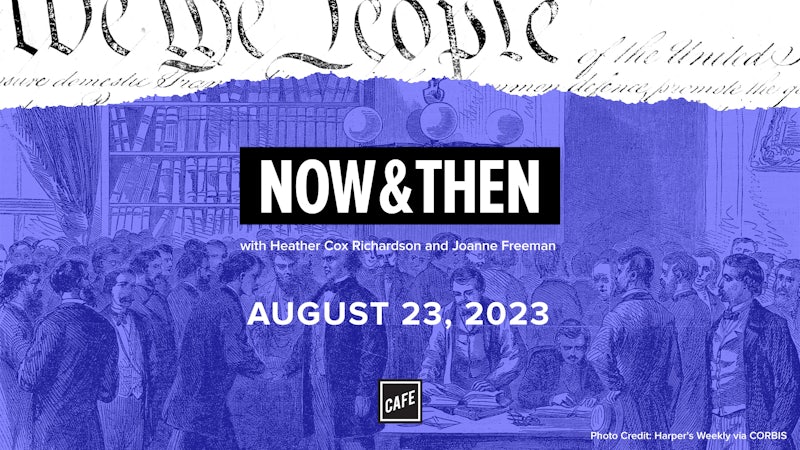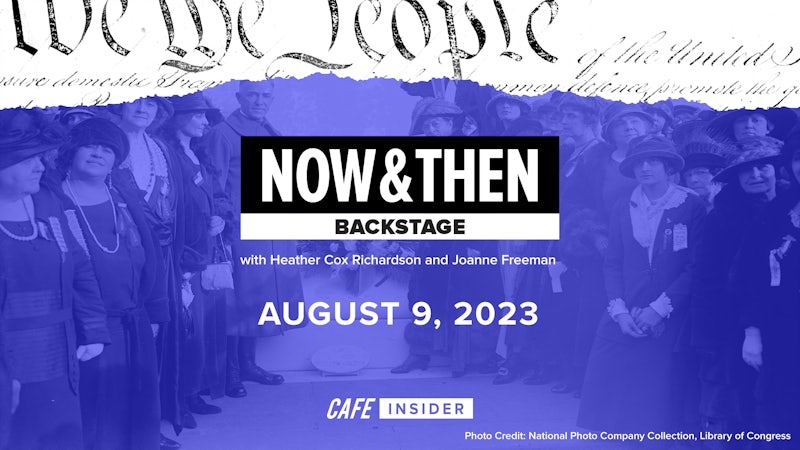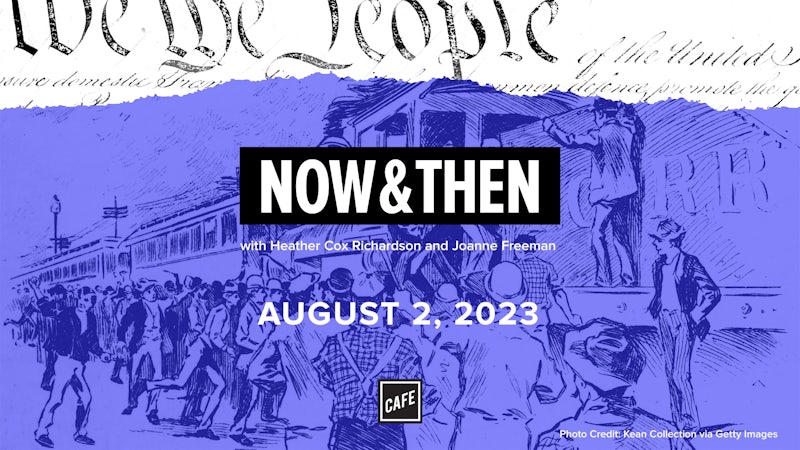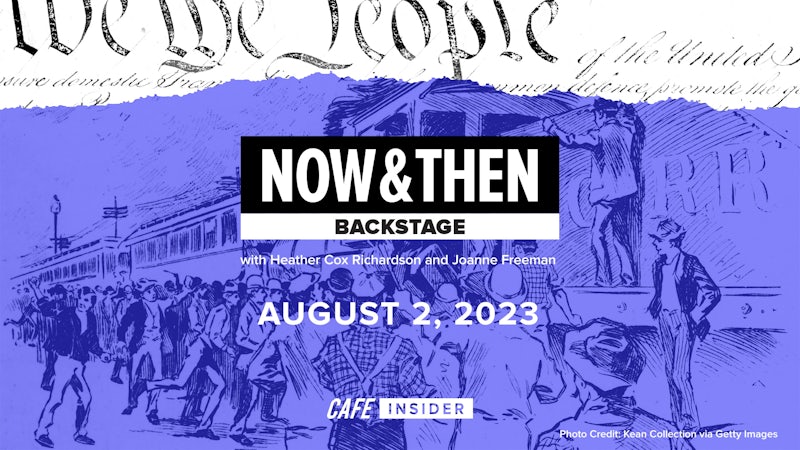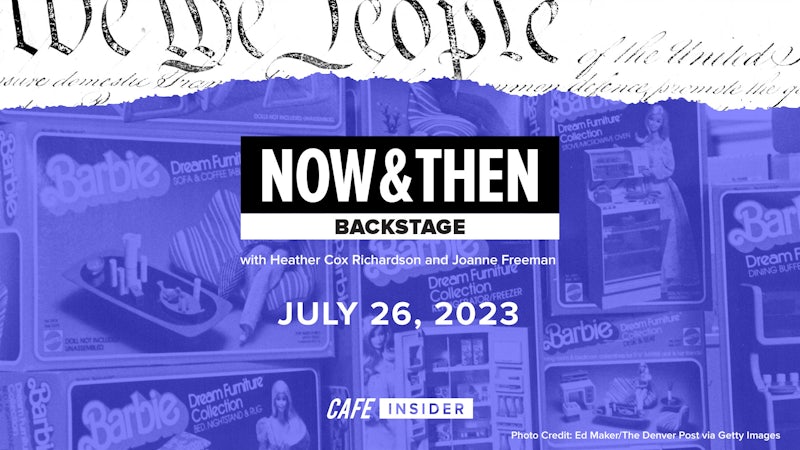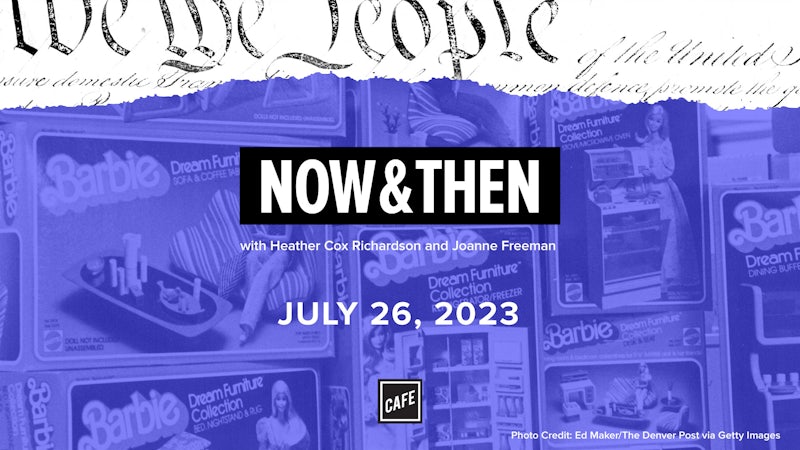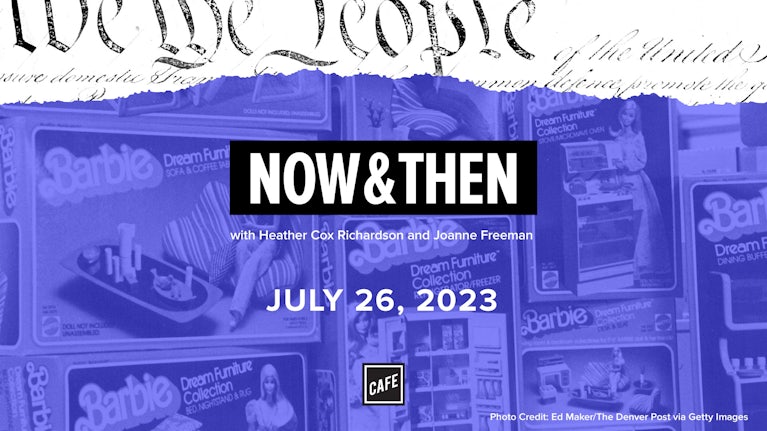Heather Cox Richardson:
From CAFE and the Vox Media Podcast Network, this is Now & Then. I’m Heather Cox Richardson.
Joanne Freeman:
And I’m Joanne Freeman. Today we’re going to talk about a topic that probably has been on the minds of a good number of you who are listening given events that have happened over the course of the last few weeks, and it has to do with UFOs, although apparently the government now refers to them as unidentified aerial phenomena, so UAP. I think UFO has more zip, unidentified flying object, but still.
So there have been a number of episodes, the first one, the one that probably most people have heard about, on February 4th, a Chinese spy balloon was shot down over the Atlantic Ocean, and it was clothed in mystery somewhat as to what was happening there and what it represented. Thought is now that it was intended to have surveillance over military bases in Guam and maybe Hawaii, but then it got carried off course and drifted to Alaska and Canada, and then entered the United States I think somewhere around Idaho on January 31st, surprising the Pentagon. And then on February 1st it made its way to the skies over a military base in Montana, where it was publicly reported, and that’s when it came on our, I use radar screen a lot in conversation and it’s rarely appropriate, and yet here it is, for the first time.
So then in addition to that, which we actually knew what it was, in February there were three UAPs shot down. One was shot down off of Alaska and it broke into pieces, probably not a balloon, supposedly. A White House official said it was the size of a small car, which is rather impressive. Then the next day, February 11th, another one was shot down over Canada. It was downed over the Yukon, which borders Alaska. It was described by a Canadian official as being cylindrical and smaller than the Chinese by balloon. And then the next day, February 12th, another UAP was shot down over Lake Huron. It was octagon shaped and had strings hanging off of it. But it’s unclear what any of these three things were, there’s still really not a consensus over what they are.
So the Chinese spy balloon is what started this whole phenomenon, and now in a way we, and others, are looking up at the skies and finding other things up there.
Heather Cox Richardson:
Heck of a lot of things going on up there, Joanne.
Joanne Freeman:
She said from Maine.
Heather Cox Richardson:
The whole idea of the way that people living in the United States have looked at UFOs and interpreted UFOs, really since even before there was the United States, says a lot about who we are, and a lot about our hopes and our fears. So I’m going to try to play this one absolutely straight, because I think it’s important to take cultural phenomena really seriously.
Joanne Freeman:
I agree with your point, which is what we’re talking about, one way or another, today is the fact that these various UFOs, what’s fascinating about them, or at least what fascinates me about them, is that they say a lot more about the people seeing them than about anything else. And so to get that, I think just like you said, Heather, you have to take it seriously, because the people who see it and report it did, and that’s the only way we can try to crawl into their head and try and understand what they thought they saw, and what it might have meant, and how it shows something about the time that they were in.
Heather Cox Richardson:
So what’s interesting about the modern moment, on the heels of that Chinese spy balloon, that we do have a pretty good sense of what was happening, and it told us a great deal about Chinese aspirations for control, not only of the Indo-Pacific, but also to tweak the United States a little bit. So while that told us a lot of things, the objects that came afterward permitted politicians of one side or another to read into what might be in those skies and what it says about President Biden’s ineffectually, “Oh look, these must be more spy balloons, and he’s not taking enough proactive measures against China,” or, “Oh no, we trust Biden.” And the truth is because they remain UAPs, or UFOs, for all we know they’re really fat birds.
Joanne Freeman:
Oh God. Okay, I can’t play it straight if you’re talking about fat birds.
Heather Cox Richardson:
The point is we don’t really know what they are, and people are reading into them what they would like them to be, what they would like them to represent.
Joanne Freeman:
Or what they think they represent. The thing that gets me is if you’re 20, 30 years from now looking back, what you’re going to say is, these things were shot out of the sky and they were immediately made partisan. There was a huge, immediate, polarized response, “We on this side think they’re this, and we on that side think they’re that,” so that if you’re trying to get at the ethos of this moment, the fact that there are things floating around in the sky and they immediately become Republican versus Democrat tells you a lot about this moment.
Heather Cox Richardson:
That idea of something on which we can project our hopes and our fears is really interesting when you think about our society. Things coming from outer space, or coming from the air, have given people that sort of mirror since the very beginning.
Joanne Freeman:
So let’s talk, very briefly at least, about the fact that yes, they certainly wouldn’t have seen them, what we now define as UFOs, but there were strange sightings of things going all the way back at least to the 17th century. But as we suggested at the outset, and I think as it’s going to become clear throughout this episode, people understood what they saw and what they wanted to see in the context of the time. So for example, Increase Mather, the great New England Divine Increase Mather, wrote a book called An Essay for Recording of Illustrious Providences, and in there he includes some things that he saw in the sky, lights, or whatever, that were strange sight. But his take on that was it clearly has a religious or a spiritual implication, that in some way or another it’s a sign of something that this very religious minded people could read and understand if they were only looking.
Heather Cox Richardson:
Certainly when the Mathers are doing their thing, there is a link between the fact that God is sending signs because God favors you, and perhaps God is sending signs because he’s mad at you. So it’s a double-edged sword. Look, we’re being noticed by God, we must be important, but oopsie poopsie, he’s noticing us because we screwed something up.
Joanne Freeman:
You managed to have an oopsie poopsie about puritans.
Heather Cox Richardson:
That’s why they pay me the big bucks, Joanne. I just love the humanity of it, because throughout this entire thing, it’s not like we’re going to say, “Oh, in 1917 they really cared about UFOs.” There’s been this UFO strand throughout American history, and it says this is what we hope, and this is what we’re afraid of.
Joanne Freeman:
Exactly, and the fact that it is both of those things at the same time, in a way, is the most fundamental and even most profound way you can talk about humanity, the condition of being human, of all. It’s a book that’s full of, as he puts it, Illustrious Providences, different signs and things that he and others saw that have some kind of deeper meaning. He certainly wasn’t saying there are people outside the earth who are beaming in to send us a message, or something, he framed it in the context of nature and God communicating something, or reflecting something, or symbolizing something.
Heather Cox Richardson:
The other piece of the early sightings that jumps out at me is if you look at John Winthrop, for example. He, of course, was one of the founders of the Massachusetts Bay Colony, and these people are facing a continent that is alien to them, with a lot of things that are really alien to them. One of the things that freaks out the early New England settlers are lobsters. They’re basically giant cockroaches, and they’re really giant. I mean, they’re feet long, and they can really do damage to your leg, and all that. There’s all kinds of these phenomena that somehow they have to work into their worldview.
Joanne Freeman:
So Winthrop took note of some of the things either that he saw, or that others saw, and in great detail. I will offer one only because it’s so striking. He describes how, for example, in this year one John Everall, a sober, discreet man, and two others saw a great light in the night at Muddy River. “When it stood still it flamed up and was about three yards square, when it ran it was contracted into the figure of a swine. It ran as swift as an arrow towards Charlton, and so up and down about two or three hours.” What strikes me about that is it looked like an animal, and I think very much along the lines of what you just said, Heather, when you read about what confronted, as far as nature, these early settlers that came to North America, not only were there creatures they had never seen, there were vast numbers of them.
Heather Cox Richardson:
And if you could have something as weird as, I’m sorry, I’m going to pick on lobsters again, because we’re in New England. If we were in Louisiana I’d be picking on alligators. If you could have something as weird as that in this new kind of world, why couldn’t you have something made of fire that runs into the sky? Why couldn’t that be an animal? And I think you’re going to see that again throughout this episode as well, that when confronted with a new technology people say, “Well, if we can do X, why can’t we do Y?”
And it is also worth, I think, pointing out that Winthrop is really into this idea of there being ghostly fire figures in the air, and what that might say, it’s almost a marriage of the Puritan vision and the ecological vision. He reports on another sighting, saying that a man resembled Captain Chaddock. Captain Chaddock had died in the vicinity and had professed a skill in necromancy and says of the sighting, “Sometimes they shot out flames and sometimes sparkles. About the same time a voice was heard upon the water between Boston and Dorchester calling out in a most dreadful manner, ‘Boy, boy, come away, come away,’ and it suddenly shifted from one place to another a great distance, about 20 times.”
People do speculate that what Winthrop and his peeps were really seeing was a very common visual phenomenon that appears over the marshland in the night when gas rising from organic matter that’s decomposing begins to catch flame. I mean, there’s all kinds of things that would actually cause flame in a marshland.
Joanne Freeman:
There are actual reasons why he might have actually seen that.
Heather Cox Richardson:
That’s right, he might have seen something, but it was not, I’m going to go out on a limb here and say it was not in fact some supernatural thing.
Joanne Freeman:
I was going to say, let’s beam ahead. There are a lot of words in the English language that sound like UFOs. But let’s beam ahead into the 19th century and look at another moment when something, it stands out because thousands of Americans across the country thought that they saw a UFO.
Heather Cox Richardson:
This is the period characterized by what were known as mystery airships that traveled over the United States. But what I love about this period is think of the technological change going on. So you can speak over a telegraph now, and a telephone if you’re wealthy enough to have one, meaning that you can speak to your relatives a long way away who previously were lost to you after they moved two towns over, maybe you’d exchange a letter or two in the rest of your lifetimes, but now you can literally pick up this thing and talk to them, or communicate with them.
So people start to wonder about, well, maybe you can communicate with dead people, they get spiritualism, and maybe you can communicate with people from elsewhere. Now at the same time you have the rise of things like, and I’ve mentioned this before on this podcast, the Ferris wheel, which lets you get off the ground in a way that most people couldn’t have gotten off the ground, certainly before 1873 and steel frame construction, but being able just to get in this wheel and go up into the air. Well, if you can go up into the air on a Ferris wheel, why couldn’t people go up into the air in other ways as well?
Joanne Freeman:
It’s worth thinking about the fact, because I totally agree with that, the sense of possibility, because of all of the technological change made it possible for people to imagine any number of things being possible. And what it reminds me of, if you think about our current moment, and if tomorrow someone said, “There’s been a new form of technology created that can form an exact duplicate of your brain and funnel that into a program,” we could believe that, it’s not crazy, because in our moment there’s computer technology, software technology, that any given moment something weird happens.
What we do in this particular moment with software and computer technology, and anything is possible, that’s very much the ethos and spirit that we’re talking about when we get to the late 19th century when, why couldn’t there be things flying? Why wouldn’t there be things that we just don’t know about, but they’re very much in league with all of these other wild things. Throw in their railroads, steamships, all of these things in the 19th century that weren’t imagined before.
Heather Cox Richardson:
And what I love about this particular period is that if the Increase Mather images were potentially frightening images, these are so hopeful. So people have begun, in this period, to imagine that everything is going to be done by air travel, and it’s still just a dream, but between November 1896 and May of 1897, for a lot of Americans it became something more than a dream.
Joanne Freeman:
Now the first reports came from Northern California in November of 1896, and the San Francisco Chronicle had a story that said that a number of Sacramento residents had seen a cigar shaped dirigible and had heard human voices coming from within it. And there were various explanations, someone stepped forward, a lawyer stepped forward, claimed to represent the man responsible for this airship, “It was my client’s airship that the people saw.” Within weeks there were reports of airships in 19 different California counties. The Fresno Republican said that the whole phenomenon was just increasingly ubiquitous, and actually went on to say, “The town which has not had its air shipped might as well come off the map. If it is alive, it doesn’t know it.”
So everyone is having this breathless encounter, “Look what we’re seeing.” The San Francisco Examiner captured that mood with a 72 line iambic trimeter poem. I love when they create poetry in the 19th century about everything. That was some of the most fun I had in writing my last book. So the San Francisco Examiner, I offer you four bad lines of poetry. “Oh, say you airy phantom, far up, aloft, afloat. Are you some nervous goblin who likes to steer a boat?” That sounds like Dr. Seuss, actually.
Heather Cox Richardson:
How dare you say that’s bad poetry, I think that’s great. Oh, say you airy phantom, far up, aloft, afloat, are you some nervous goblin, who likes to steer a boat?
Joanne Freeman:
You some nervous goblin who likes to steer a boat?
Heather Cox Richardson:
You and I have threatened to write a musical, one of our other many promises, and I feel like we could do as well as that.
Joanne Freeman:
I’m sure we could, and even recite it together as we just did.
Heather Cox Richardson:
It is worth pointing out here that experiments with air flight are not yet successful. While there were some successful balloon flights, Americans hadn’t gotten very far off the ground. So while we’re talking about the idea, there are these dirigibles everywhere, and everyone’s seeing them, they don’t actually exist yet. So people are seeing them everywhere, people are claiming to have built them, people are wondering who’s up there chatting away, but these things don’t actually exist.
Joanne Freeman:
But there was absolute belief that they were there and people just didn’t know about it. So for example, the Trans-Mississippi Exposition, there was a claim that they were going to include one of these kinds of airships there so that people could actually see it. That did not happen, but the fact that people believed that that could happen is pretty remarkable.
Heather Cox Richardson:
This is one of my favorite reactions to this, and in a way you don’t have to be a historian to figure this out. Lots of people in California are like, “Wow, look, I’ve seen it too, there’s people up there talking, all this stuff’s going on.” How are people going to react? At least some Americans are going to say, “Ooh, California.”
Joanne Freeman:
I know. That was my thought about all of the material I was reading for this, it was like, wow, that sort of wacky California goes pretty far back.
Heather Cox Richardson:
So in Portland, Oregon, which did not experience, apparently, the same phenomenon, it used the rumors from the San Francisco press to condemn all of California as an overly luxuriant and barbaric society. “The fake flourishes through all the school of journals that imitate the New York world, which first used it as a constant and simple stock-in-trade, but it has reached its most luxurious development in San Francisco, whose newspapers print little else. It is easy to understand, from the history and social conditions of California, why it should afford a soil peculiarly adapted to fake cultivation. California society unites, strangely enough, many of the human sentiments and susceptibility of the barbaric state with those of an overripe civilization.”
Joanne Freeman:
Sorry, California, if you’re listening.
Heather Cox Richardson:
But then, California’s barbarity spread east.
Joanne Freeman:
In 16 Midwestern and Southern states, and different people are coming forward claiming that they had these visions, it was seen in Texas. In the end, as we’ve suggested all along here, there wasn’t any specific thing that people were necessarily seeing, but they could readily believe that they could see something because of everything else that was existing technologically around them that they couldn’t imagine before. Certainly flight could be possible, certainly you could be in the air, certainly things that they had never imagined could be happening, and you can also understand how once some people, even if they were in the barbaric California, claimed to have seen this, how any other number of phenomena could have brought people to the same mindset that they too thought that they’d saw one of these airships.
Heather Cox Richardson:
And you didn’t want to be the one left behind.
Joanne Freeman:
Right.
Heather Cox Richardson:
If everybody else was seeing it and moving forward to this new vision, you weren’t going to be the one left behind. I also like that in Dallas, the Dallas Morning News went the obvious place with this, saying that the crew had reported that they have been making an experimental trip to comply with a contract with certain capitalists of New York who are backing them. Robber baron era, right? “They are confident that they have achieved a great success and that in a short time the navigation of the air will be an assured fact. They refused to have their machine critically inspected, and refused to talk further as to their plans for the future.”
Again, a way you look at the late 19th century as one of extraordinary possibility, that’s backed by robber baron’s money, that might move the country into this entirely new world, and other people being like, “Yeah, right, this is not a good use of Americans’ imaginations, because this ain’t never going to happen.”
Joanne Freeman:
But now what that quote from the Dallas Mornings News introduces that will continue to be a thread, and actually will pull us a little bit further in time, is a vague idea of a conspiracy. There’s something happening, they won’t talk about it, they won’t let anyone see it, and they’re not going to talk about anything having to do with it until the future when they can reveal more. There’s an aspect there of secret things happening that we don’t know about, and at some point in the future all will be revealed.
Heather Cox Richardson:
A conspiracy and a conspiracy that covers a fear. What might those capitalists be doing? What might those secret people be doing? And that’s really going to come to the fore about 40 years later in what became known as the Battle of Los Angeles.
Joanne Freeman:
So on February 23rd, 1942, a Japanese submarine off the coast of California shelled the Ellwood Oil Field, which is near Santa Barbara, and it put everything on high alert in Southern California. About a day later, at 2:00 AM, military radar picked up what seemed to be an enemy contact about 120 miles west of Los Angeles. Now again, we’re talking about 1942, so we are talking about the context of World War II, and again, think about that context as we’re thinking about what people are thinking they’re seeing and how they’re responding to it.
Heather Cox Richardson:
And just at the beginning of World War II, because if you’ve got Pearl Harbor on December 7th of 1941, this is-
Joanne Freeman:
February.
Heather Cox Richardson:
December, January, February, so it’s not even three months later.
Joanne Freeman:
So troops in Santa Monica unleashed 1,400 rounds of anti-aircraft ammunition over the course of 90 minutes. Lit up the sky over Los Angeles. There was a citywide blackout put into effect, of course people were sitting on roofs and watching what was going on. The LA Times rather breathlessly reported, “Powerful search lights from countless stations stabbed the sky with brilliant probing fingers.” Boy, purple prose, “while anti-aircraft batteries dotted the heavens with beautiful, if sinister, orange bursts of shrapnel.”
Now as the day wore on, there wasn’t really hard evidence of enemy aircraft. The Secretary of the Navy said in a press conference that the whole thing was because of a false report of enemy aircraft. He said, “As far as I know the whole raid was a false alarm, and could be attributed to jittery nerves.” Now again, think about the moment that we’re in, and Pearl Harbor has just happened. This will be a moment when people are worried about enemies coming from the skies, doing things that you’re not expected for, surprises, violence. The idea of some kind of extraterrestrial invasion certainly is in line with those kinds of accidents and fears.
Heather Cox Richardson:
Well, and the Secretary of War, Henry Stimson, actually did issue a contradictory statement saying that there had in fact been 15 unidentified aircraft over LA. The response to this indicated a lot about what unidentified flying objects meant for society. When the New York Times wondered aloud about the possibility that US defense forces had been easily infiltrated, the Times said, “Is it possible that our whole system of supervision is so lax that a group of enemy aliens can casually take off from their own planes on nearby American airfield and fly over our cities at night?”
And a Republican representative from California, Leland Ford, made a speech about how angry he was about the lack of information about the raid, even suggesting that the incident could have been military setup by the Eastern establishment to sabotage Southern California’s economy. He said, “This either was a practice raid or a raid to throw a scare into 2 million people, or a mistaken identity raid, or a raid to lay a political foundation to take away from Southern California’s industries.”
Joanne Freeman:
Now it’s interesting because as we’re talking about this, and as we have government officials contradicting each other, and even in the statement you just read, Heather, “Well, it was either this, or this, or this, or this,” it’s certainly going to make it harder for people to believe what the government is telling them. And Wendell Willkie, the utilities magnate who had challenged President Franklin Delano Roosevelt for the presidency in 1940, he says, actually, point-blank, “Conflicting statements from the heads of our armed forces tend to discount what they may say in the future. It was the same lack of coordination and confusion that brought the disaster at Pearl Harbor.” Again, another aspect of this, maybe there’s a conspiracy of some kind and there’s a different reason for these, and what does it say about our government?
Heather Cox Richardson:
Well, and then there’s another layer that gets added over the top of this when in early March the Hollywood journalist and screenwriter Frank Nugent, who actually went on to write the John Wayne western The Searchers in 1956, put an essay in the New York Times in which he argued that it was Hollywood’s culture of fantasy that had made people in Los Angeles particularly prone to imagining UFOs. And he went on to suggest that there were so many airports and so many aircraft factories around, and so many other things having to do with the motion picture industry, like big red balloons that are anchored with cables, there’s a warning for planes to steer clear of the shooting less their motors filter through the sound stages and ruin outdoor shots. There’s all sorts of things in the air around LA, and that made them especially susceptible to imagining that there was something scary and dangerous up there.
Joanne Freeman:
I never knew about those balloons, that surprised me when I was reading and preparing for this, that the studios flew balloons, cable anchored, to warn planes to steer clear so that they didn’t interrupt what they were recording in the studios? I don’t know, that somehow or other stuck me as practical and logical and weird.
Heather Cox Richardson:
So there is, of course, fallout from this particular UFO incident in that there’s a wave of anti-Japanese sentiment on its heels. In Los Angeles authorities arrested 20 Japanese Americans, accused them of being involved with coordinating the raid, and it became a factor in the vigorous enforcement of the executive order for Japanese internment, which President Roosevelt had signed just days before the raid. And yet, in 1983, the Office of Air Force History suggested that the supposed enemy craft in the air over LA in 1942 were likely meteorological balloons that had just been released to try and help to determine the wind conditions there. So people saw in the air some kind of balloons, and in this fraught moment they became enemy aircraft, huge barrage to bring them down.
Joanne Freeman:
They certainly at least had some kind of an impact on actual views about legislations, which is the other half of what we’re saying here, is that, as you pointed out, Heather, it’s important to remember the humanity of this, the humanness of this. The other side of that is this isn’t just freely stuff happening and having no impact, it potentially could have a serious impact.
Now one thing which we haven’t mentioned yet, and it almost is hard to imagine discussing this topic without mentioning it, is the 1938 drama that unfolded around Orson Welles’ radio program of the War of the Worlds that was part of the Mercury Theater on the Air radio show.
So Welles and his cohort took a 40-year-old novel and they changed it into something that supposedly sounded real, that included news bulletins, and any number of other things that made it sound as though what was unfolding was real news announcements about an attack of aliens in New Jersey. The original novel, I think, picked Great Britain, but now it’s New Jersey, and that some listeners mistook the bulletins for the real thing and began making phone calls. It had a huge impact in a way that Welles and the people working with him really hadn’t intended.
Now supposedly one of the reasons why it had the impact that it did is there was a statement that this was fiction at the very beginning, but if you tuned in late, normally at the half hour mark there would be a break in a radio show for some kind of advertisement. This did not stop at the half hour mark, the break in the show was much later. So if you beamed in a little late to listening to this, this newscaster saying, “Oh no, they’re getting off their spacecraft in New Jersey, there’s laser beams, there’s gas coming from the skies.”
Heather Cox Richardson:
In fairness, I think he was a little more convincing.
Joanne Freeman:
Yes, yes, he was. I’m sorry, I’m getting way worked up at the idea of this. But it sounded convincing, as a matter of fact, they very much tried to get actors who could sound either like radio broadcasters or political figures, I think they had the supposed Secretary of the Interior make a report on what was happening.
War of the Worlds (archival):
At this time we take you to Washington for a special broadcast on the national emergency. The Secretary of the Interior.
Citizens of the nation, I shall not try to conceal the gravity of the situation that confronts the country, nor the concern of your government in protecting the lives and property of its people. However, I wish to impress upon you, private citizens and public officials, all of you, the urgent need of calm and resourceful action. Fortunately this formidable enemy is still confined to a comparatively small area, and we may place our faith in the military forces to keep them there. In the meantime, placing our faith in God, we must continue the performance of our duties, each and every one of us, so that we may confront this destructive adversary with a nation united, courageous, and consecrated to the preservation of human supremacy on this earth. I thank you.
Joanne Freeman:
Now in this moment, you had recently had the depression, you did have a gathering crisis in Europe, there was the Hindenburg disaster. There were any number of things that would’ve made Americans rather jittery, and already the idea of magical, weird, mysterious spacecraft was part of the national culture. So for all of these reasons, the War of the Worlds had a huge impact.
Heather Cox Richardson:
And actually one of the things that happened is people panicked, there were reports of suicides over this announcement. It’s so interesting because it’s a work of fiction, and yet it is also in some ways a precursor to ideas of disinformation. It sounded like a true news broadcast.
Joanne Freeman:
Deliberately.
Heather Cox Richardson:
Deliberately, it was believable enough, even though we look at it now and say, oh, it’s a pop culture hoax, and it tapped into this idea of I’m really important and I’m under threat, and that’s one of the aspects of UFOs that has been a constant for people living in this country.
Joanne Freeman:
Ironically enough, for something that’s this big spacial phenomenon, people respond to it in a very personal way. This is about me in some way, about us, it’s coming to us. There’s a personal link with this so that it isn’t just something up in the skies, actually we see that from the very first instances that we discussed, a providence, what’s happening is a providence. In some way or another what we’re seeing reflects something about us and who we are, and maybe indeed suggests that we are important enough to be noticed.
Heather Cox Richardson:
And then, of course, by the 1960s we’ve got another wave of new technology that is going to focus people on space through things like the Apollo program, and also through the rise of Gene Roddenberry’s Star Trek, which was an attempt to take the themes of the American West into a space western.
Joanne Freeman:
There are things that happened in the 60s that show that whatever people are thinking about UFOs, some of them are thinking along the lines of War of the Worlds, it might not be so wonderful. What are the UFOs? Who are they? Maybe this represents some kind of dramatic, massive danger. And a very specific example of this, and I remembered this, but I couldn’t put details to it, I actually looked it up for this, was a Twilight Zone episode from 1962 titled To Serve Man.
Heather Cox Richardson:
Oh man.
Joanne Freeman:
Exactly, that’s what I did. So this is the opening to the episode.
Rod Serling (archival):
Respectfully submitted for your perusal, a Kanamit. Height, a little over nine feet. Weight, in the neighborhood of 350 pounds. Origin, unknown. Motives? Therein hangs the tale, for in just a moment we’re going to ask you to shake hands, figuratively, with a Christopher Columbus from another galaxy and another time. This is the Twilight Zone.
Joanne Freeman:
It’s an episode that very much captures the idea of danger in the skies. Like yeah, they’re coming for us, but why?
Heather Cox Richardson:
Yeah, yeah, and they’re coming for us under terms that look really good, but. And that danger is going to run through so many of the attempts to talk about what outer space might be like from then until the present.
Joanne Freeman:
Except there is a cultural moment in the 1970s when the assumption is that in one way or another it’s earth that’s the problem, and it’s the UFOs who represent some kind of advanced way of seeing things. And we’re talking about things like Close Encounters of the Third Kind. In November of 1977, Close Encounters of the Third Kind, Steven Spielberg’s movie, comes out in American theaters. It ended up being nominated for Nine Academy Awards, it won one for cinematography. It starred Richard Dreyfuss as an Indiana electrician named Roy Neary, who experiences several close encounters with UFOs. And he’s convinced he’s seeing something, he doesn’t know what it is, he’s obsessed with it, he’s drawing pictures of it, he never stops talking about what he sees. He alienates his wife, Ronnie, who’s played by Teri Garr, and ultimately goes on this obsessive quest to view this spacecraft that he’s sure is somewhere that he’s thinking about and he just has to figure out where it is.
Heather Cox Richardson:
Once again, he’s chosen. What that means, it’s not clear, but he’s chosen, and nobody else understands it. And can I just throw out here what a brilliant actor Teri Garr is?
Joanne Freeman:
Yes.
Heather Cox Richardson:
Have you ever seen her be bad in anything?
Joanne Freeman:
No.
Heather Cox Richardson:
But again, the idea that this is no longer something that everybody knows, this is unique to him, he has the inside track. Rather like Increase Mather got the inside track for the Puritans, and rather like the idea that it shows you are somehow special, but maybe that’s not such a good thing.
Joanne Freeman:
Well, he ultimately does find his way to where this spacecraft is supposed to be, there’s a mountain range, Devils Tower Monument in Wyoming, and he makes a pilgrimage there. What he finds is that, as you just said, Heather, yeah, he’s chosen, but there are a number of other people who clearly have been chosen as well, and he meets up with one of them, and they become partners in their search for exactly what’s going on. So Richard Dreyfuss’s partner in that search is played by actress Melinda Dillon, who actually passed away just a few weeks ago, and was acclaimed for her part in this movie as well.
Now what fascinates me is that when this movie was initially conceived by Steven Spielberg, what he was going to focus on was a Watergate like conspiracy hiding the UFO. It becomes something that’s spiritual and even religious. It starts out being absolutely of the moment, it’s going to echo political corruption and conspiracy theories, and it’s not until he starts talking about it with others that it evolves into the shape it ultimately takes.
Heather Cox Richardson:
And yet there’s an element in that that continues to be that conspiracy-minded thing. They have to work around the government agents who are trying to keep this visit a secret, and again, be chosen themselves by the people landing on Devils Tower.
Joanne Freeman:
So in the creation of the movies, Spielberg brought on, I have to mention this because it’s a fellow professor, Professor J. Allen Hynek as a consultant, and apparently Hynek had worked with the Air Force on UFO research in the 1950s, and he had pioneered the close encounter classification system in a book that he wrote in 1972 titled The UFO Experience. And by his system, a close encounter of the first kind meant UFOs seen at a close enough range to be able to make out some details. A close encounter of the second kind had a physical effect, so scorching trees, or scaring animals. A close encounter of the third kind meant that witnesses reported seeing extraterrestrials in or near a UFO. So what we’re looking at is a close encounter of the third kind in this movie.
Now Hynek argued that Spielberg’s movie captured the growing focus on UFOs really that was taking place in American society at large. He said, “Even though the film is fiction, it’s based, for the most part, on the known facts of the UFO mystery, and it certainly captures the flavor of the phenomenon.” It did, in the end, have more of a religious or spiritual flavor than Watergate, although as you just said, Heather, that’s certainly in there, but there end up being notes, musical notes, that end up being played, they’re a form of communication.
Those are the five notes which have been in my head for two days.
Heather Cox Richardson:
Since 1977.
Joanne Freeman:
Probably.
Heather Cox Richardson:
Ray Bradbury, who was the writer of Fahrenheit 451, and The Martian Chronicles, loved Close Encounters of the Third Kind. He wrote a review in the LA Times in which he said the film made a global statement. He called it, “The most important film of our time, for this is a religious film in all the great, good senses, the right senses of that much battered word. Spielberg has made a film that can open in New Delhi, Tokyo, Berlin, Moscow, Johannesburg, Paris, London, New York, and Rio de Janeiro on the same day to mobs and throngs and crowds that will never stop coming because for the first time someone has treated all of us as if we really did belong to one race.”
So in this period, in the 1970s, a period that many people, I think, today tend to forget was extraordinarily optimistic, we seem to focus more on the oil crisis in the United States, for example, and some of the fallout from that, and the hostage crisis, and yet there was also this sense that if we did it right we could all work together and all regain the kind of innocence and love for each other that perhaps people who were guarding Devils Tower, the government agents, had lost sight of, and Bradbury certainly seemed to buy into it.
Now, not everybody did. Arthur Schlesinger Jr., a historian, said, “How can we be so sure that a civilization sufficiently in advance of our own would regard us with any more consideration than white intruders from Europe regarded the Indians of the American continent, the Blacks of Africa, or the primitive peoples of the South Pacific?” So he went on to say, “Let us pray that the future dreamed of in this humane, attractive, brilliant movie turns out to be right,” to serve man, if you will.
Joanne Freeman:
Now there Schlesinger is mentioning how white intruders encountered Blacks of Africa. There’s a strain of UFO culture that is distinct and different from some of what else is happening here, and it has to do with Black Americans and their views of UFOs, and I find this absolutely fascinating. So at this period, increasingly, and I’m talking now about the 60s and the beginning of the 70s, there are often white tales of UFOs being scary and dangerous and we don’t know what they want.
Black accounts of UFOs almost universally talk about UFOs as being friendly, and imagine a world that is different from the world that they’re in. If the world that they were in, if the United States, particularly, is seen as anti-Black, many Black people looked out into the heavens and saw other people’s and a way to reimagine who they were as a way to have something different, to have superior people come down to earth, and again, as we’ve said before, choose these people and take these people in and allow them to expose and experience their power in a world that is so structurally anti-Black.
You have a number of Black musicians in this period who engage in, incorporate into their work, and even say that they’ve had personal encounters with UFOs. You have George Clinton and Bootsy Collins, who claim that they saw UFOs, incorporate that into their music. You have Black jazz composer and musician, and also someone who did a lot of experimental music, Sun Ra, who claims that he was taken on a trip somewhere by a UFO, and in his theology he said that Black people were part of an angel race, a cosmic race. And again, pulling the Black experience out of earth and the United States, rising above slavery, rising above systemic racism, and experiencing and imagining something different.
Heather Cox Richardson:
Is it fair to say that there too, as people are experimenting with their spirituality and with psychedelic drugs in the 1970s, this idea of escaping to another world of freedom and beauty and power finds its way into Black music, into afro-futurism, and into this idea of there being, once again, we’re chosen, but in this case there’s not a downside, we’re chosen and we’re going to escape to something better. But I love the idea of Parliament and the galaxy that they create with the Funkapus and Dr. Funkenstein are, I hate to do this to you, but in so many ways reminiscent of Increase Mather.
Joanne Freeman:
Wow.
Heather Cox Richardson:
Well, but really, if you’re looking at that idea that you’ve got new technologies that prove you’re chosen, and that there is another world out there for you.
Joanne Freeman:
A higher meaning.
Heather Cox Richardson:
And a higher meaning, that thread runs through American history, and there’s no reason that the afronauts and Increase Mather aren’t really drawing from that same combination of being the chosen, confronting new technologies in a new landscape, and fears of what might be embedded in that at the same time.
Parliament (archival):
Funk upon a time, in the days of the Funkapus, the concept of specially designed afronauts, capable of funkatizing galaxies, was first laid on man child, but was later repossessed and placed among the secrets of the pyramids until a more positive attitude towards this most sacred phenomenon, clone the funk, could be acquired. There in these terrestrial projects it would wait, along with its cohabitants of kings and pharaohs, like sleeping beauties, or the kiss that would release them to multiply in the image of the chosen one, Dr. Funkenstein stuff, and funk is its only war. Did I frighten you?
Joanne Freeman:
So really, in a way, what we’re talking about again and again, and it’s the balance that shifts, in the current moment UFOs reflecting real fears, and some of these are very earthly grounded foreign relation fears, and as we said at the beginning, also real hopes that there’s a lot of emotion, and a lot of intention invested in what we think about UFOs at any given moment. And that, as we’ve seen throughout this episode, it permeates into popular culture, it potentially has an impact on politics, it infuses itself with religion, it has an impact on conceptions of race, that in one way or another the idea of aliens from someplace else beaming down here and, for better or worse, choosing us, has a real power to it that certainly helps explain some of the reasons why this is such a pervasive thread throughout American history.
In a way, it makes me want to link it a little bit in an American context to American exceptionalism, the idea that as a nation somehow we’re special, we’re better than the rest of the world, and in some ways UFOs, people who are looking at UFOs, the positive spin on that can be a version of that, which is somehow we’re chosen, like good old Increase Mather, who has been mentioned more in this episode than I would’ve expected.
Heather Cox Richardson:
If anybody had said an episode about UFOs would feature Increase Mather, I suspect that it would’ve surprised a lot of people.
Joanne Freeman:
That’s true.
Heather Cox Richardson:
But that, I think you’re exactly right, that idea that people in this country are chosen by some extraterrestrial.
Joanne Freeman:
Superior.
Heather Cox Richardson:
Extraterrestrial, superior beings of some sort, and that’s both a sign of exceptionalism, and the potential for disaster, has been a thread running through our history from the start.












